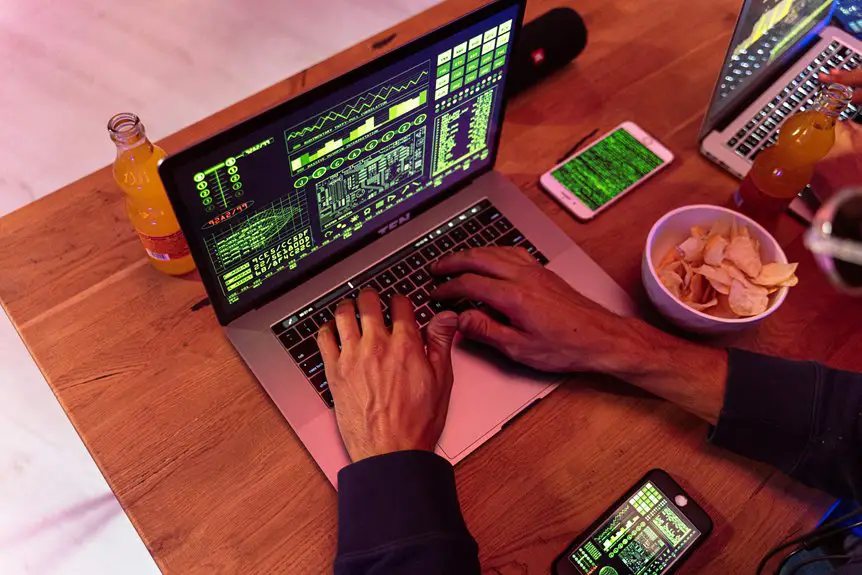In today’s digital landscape, ensuring your communication remains private is more important than ever. End-to-end encryption (E2EE) offers a robust solution by keeping your messages secure from prying eyes. By understanding how E2EE works, you can better protect your conversations from hackers and unauthorized access. But what exactly does that mean for you and your online interactions? Let’s explore the intricacies of this essential technology.
Table of Contents
Key Takeaways
- End-to-end encryption (E2EE) ensures only the sender and recipient can read messages, protecting privacy and confidentiality.
- Messages are encrypted on the sender’s device and decrypted only on the recipient’s device, preventing unauthorized access.
- E2EE is commonly used in messaging apps, email services, and file-sharing platforms for secure communication.
- While E2EE enhances security, it complicates law enforcement access and risks data loss if encryption keys are lost.
- Users should be aware that E2EE does not protect against threats like phishing attacks, emphasizing the need for additional security measures.
What Is End-To-End Encryption?
End-to-end encryption (E2EE) is a security measure that guarantees only you and the intended recipient can read the messages exchanged between you.
This technology guarantees that, even if someone intercepts your communication, they won’t be able to decipher it. E2EE protects your privacy by encrypting your messages before they leave your device and only decrypting them on the recipient’s device.
This means that not even service providers can access the content of your conversations. It’s an essential feature for messaging apps, emails, and file sharing services, providing peace of mind in an increasingly digital world.
How Does End-To-End Encryption Work?
To understand how E2EE works, it’s important to look at the encryption process itself. When you send a message, your device encrypts it using a unique key. Only the intended recipient, who has the corresponding key, can decrypt and read the message. This process guarantees that even if someone intercepts the message, they can’t access its content.
Here’s a quick overview of the key components involved:
| Component | Description |
|---|---|
| Encryption | Scrambles the message for security. |
| Decryption | Restores the original message. |
| Keys | Unique codes for encrypting/decrypting messages. |
This secure exchange protects your communications from unauthorized access, making E2EE a crucial tool for privacy.
Benefits of Using End-To-End Encryption
When you prioritize your privacy in communication, using end-to-end encryption (E2EE) offers several key advantages.
First, it guarantees that only you and the intended recipient can read your messages, keeping your conversations confidential. This reduces the risk of unauthorized access by hackers or even service providers.
Second, E2EE protects your data from interception, making it much harder for anyone to eavesdrop.
Third, it builds trust in your communication, as both parties can feel secure knowing their messages are private.
Finally, many E2EE services offer additional features like self-destructing messages, giving you more control over your information.
Common Applications of End-To-End Encryption
While many people might associate end-to-end encryption with messaging apps, its applications extend far beyond just chatting.
You’ll find it in email services that prioritize your privacy, ensuring only you and your intended recipient can read the contents.
File-sharing platforms also use end-to-end encryption to protect sensitive documents, making sure that unauthorized parties can’t access your data.
Additionally, video conferencing tools implement this technology to secure your conversations, keeping them private from potential eavesdroppers.
Even in online banking, end-to-end encryption safeguards your financial transactions, providing peace of mind as you conduct business.
With these varied applications, end-to-end encryption plays a vital role in maintaining your privacy across multiple forms of digital communication.
Challenges and Limitations of End-To-End Encryption
End-to-end encryption offers impressive benefits for securing communications, but it also faces significant challenges and limitations.
One major issue is that it can complicate law enforcement efforts. When data is encrypted, agencies struggle to access vital information during investigations.
Furthermore, if you lose your encryption keys, you risk losing access to your own data permanently.
Usability is another concern; users may find it difficult to understand how to implement or manage encryption correctly, potentially leading to security gaps.
Additionally, some platforms may limit end-to-end encryption, making it less effective across different services.
Finally, while encryption protects data in transit, it doesn’t safeguard against threats like phishing, which can compromise your security from the outset.
Frequently Asked Questions
Can End-To-End Encryption Be Hacked?
End-to-end encryption is designed to keep your messages secure, but no system is completely foolproof. It can be compromised through weak passwords, social engineering, or vulnerabilities in the software. Staying vigilant is essential for your protection.
Does End-To-End Encryption Slow Down Communication?
End-to-end encryption can slightly slow down communication due to the additional processing required, but you’re often unaware of the delay. The trade-off for enhanced security usually outweighs this minor inconvenience in most cases.
Is End-To-End Encryption Legal Everywhere?
In over 60 countries, end-to-end encryption is legal, but some regions impose restrictions. You’ve got to stay informed, as laws can change. Always check local regulations to guarantee your communication remains secure and compliant.
Are There Alternatives to End-To-End Encryption?
Yes, there are alternatives to end-to-end encryption. You can use transport layer security (TLS), secure sockets layer (SSL), or application-level encryption. Each method offers different levels of security and may suit your needs differently.
How Does It Affect Digital Forensics Investigations?
Ah, digital forensics—where you’d think Sherlock Holmes could shine! But with end-to-end encryption, your investigations get trickier. It’s like trying to solve a mystery with a locked diary: good luck accessing the secrets!




